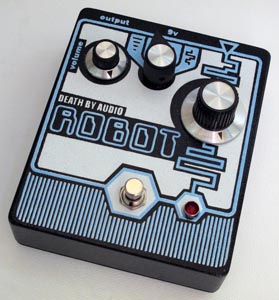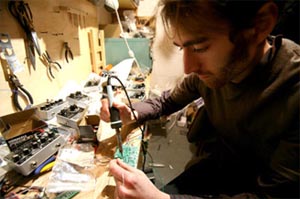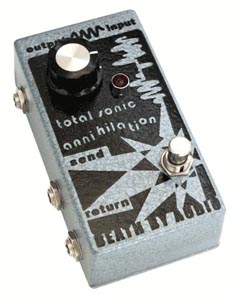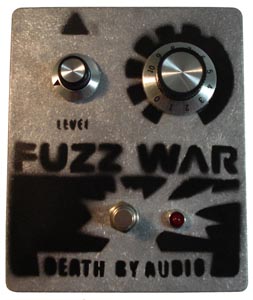Made in New York: Oliver Ackermann’s Death By Audio
WILLIAMSBURG, BROOKLYN: We veteran New Yorkers know better than to put too much stock in the fantasies of eager new-arrivals. You know the type: They come to us from small towns, accustomed to finding a monthly room to rent for little more than the sum of our daily coffees and MetroCard.
Tricked into living in our worst neighborhoods, they find themselves sliding into debt, awaking to slashed tires and stolen vans, all the while chasing a naïve dream that somebody somewhere might actually give a damn about their arty noise-rock band.
Or, at least, that’s how the Death by Audio success story begins. It ends with critically acclaimed records and a swift-selling line of innovative stompbox effects.
Although Fredericksburg Virginia’s low cost of living and and limited nightlife gave Oliver Ackermann the freedom and inspiration to start tinkering with pedals, he says that despite a trying start in the city, the company has “grown beyond anything I could have ever done by myself. And it took a place like New York to make that happen.”
Word-of-mouth has turned some of Death By Audio’s creations into instant classics: brutal boxes found at the feet of guitarists from U2, Wilco, Lightning Bolt, and Nine Inch Nails. But Ackermann, who specializes in savage tones as guitarist for A Place To Bury Strangers, is quick to admit that his pedals aren’t for everybody:
“We’re not trying to recreate pedals that other people have already done so well. We like to do stuff that’s really f*ed up, that feels like we’re glitching the system. It’s about pushing the limits almost past the point where it would be considered ‘good’. That’s the quality that people really like about some of the best old gear.”
Ackermann, who’s known for bragging that that some of his pedals could kill your amp if used without care, tells a familiar kind of story about a small company that grew gradually until it became one of those institutions that has helped define its time and place in music culture. Now, operating as a sort of collective that hosts a DIY concert space, recording studio, and record label, the Death By Audio warehouse is still churning out unique designs every day.
We caught up with Oliver to ask him about his design philosophy and the evolution of the company.
Can you tell us about your first design?
As a big effects-pedal junkie myself, I was always coming up with lots of crazy new ideas. The first one we made was a pedal that would feed your effects back into themselves. I tried to think of the most badass name I could to match the kinds of sounds we were getting, and landed on Total Sonic Annihilation.
It is a pretty great name. It catches almost as much attention as the sounds do.
Thanks, I like names that are descriptive. I try to do that with all of them: The Robot, the Sound Saw. Even the name Death by Audio, it kind of meshed with the aesthetic that I was going for, which in the beginning was really extreme noise.
How did you finally take the leap from pedal junkie to pedal maker?
I was living in Virginia when I started building effects for myself. Although it’s really cheap to live there, when I wanted to take a trip to Europe with my girlfriend-at-the-time, we just didn’t have the money to go. That’s what made me think about building pedals for real. I had like one month before we were planning to go away, and still didn’t have the money to do it!
Luckily, after releasing the first pedal and putting it up on the websites that were around at the time, like Harmony Central and others, I made enough income where I could go actually on that trip. It was really great motivation. [laughs]
You make it sound almost like a lark.
Yeah, I started almost on a whim, just sort of scrambling to find an idea where I could take one of my interests and make some money with it quickly. Sure, I thought the first pedal idea was this ultimate and awesome thing, and I’d thought about doing something like that for a while. But I guess I just needed that motivation to take a leap and make it actually happen.
So your first sales were exclusively through the internet?
Yeah, it was all through internet postings at first. After a while, word-of-mouth took over and strangers started emailing me asking for custom designs, and I just said “yes” to everything.
I’d put a price tag on each project based on a guess of what I thought it might take to make it happen. I was such a bad judge of that [laughs]. I would charge people, and I wouldn’t even know how to build the effects yet.
But it was also a great motivator. I’d say “It’ll take me two months and it’s gonna cost $500”. In reality, it might take me four months to really figure out how to make the thing work. And to design something that was really worthwhile, it might take me so much time that I was getting paid maybe a dollar an hour.
But even that was really good schooling. It kind of kicked my ass. These people could be furious with me if I was behind, and it really forced me try to come up with some of the coolest stuff I could.
Did you have any training before this trial-by-fire?
Well, I went to school for industrial design. It had nothing to do with building circuits, but it did give me the confidence to work with metal and develop the physical side of the boxes. I had learned how to silkscreen from being in bands, making records and posters and t-shirts, so that helped a bit. It kind of all came together.
Learning to build pedals was a lot like moving into our first warehouse. I didn’t know anything about construction at first, but you just figure: “Okay… Well, I wonder how you make walls and roofs and doors and stuff!” [laughs]. You just sort of have to figure it out. I guess I was always under the assumption that no matter what you want to do, you can do it if you just spend some time on it. [pullquote]You just sort of have to figure it out. I guess I was always under the assumption that no matter what you want to do, you can do it if you just spend some time on it.[/pullquote]
You make it sound easy. But something as successful as Death By Audio can’t be a one-man operation, can it? When did it first make sense to take on employees?
In the beginning, my girlfriend-at-the-time helped build some of the pedals, because it had blown up way faster than I’d thought it would. I had one of my best friends help me out for a while too, and then some roommates. I mean, they had no clue what they were doing, so I would be there working right along with them. They would do exactly what I was doing at the same time, side-by side.
One of the first guys I really hired was an immigrant in the U.S. He was doing really dangerous jobs, working with electricity and going up on to roofs for $3.50 an hour, risking his life every day because he didn’t have the right papers. When I met this guy and hung out with him for a while, I realized he was super nice and really talented. I took him in to work with me and he did a great job. I showed him how to silkscreen and all the rest, and now he has a successful silk-screening business, which is pretty cool!
Eventually, I worked my way into getting more picky, and I could hire people with electrical backgrounds, who could help out in more ways. The people who were there in the beginning had been so helpful, but they needed a lot of guidance. I really had to be there back then, showing them the process step-by-step because they just didn’t have the knowledge.
When and why did New York seem like the right move?
I was working this really great job in Virginia, designing toys. It was so super cheap and easy to live down there. I was living in this giant warehouse that barely cost a thing.
But the thing with a place like that, is there are maybe ten people nearby who you want to hang out with. Maybe three of them are people you can really relate to and collaborate with on stuff. Every time we’d come up to New York it seemed like there were endless amounts of cool people, endless amounts of awesome stuff going on, no matter what day of the week it was.
I just wanted to be involved in that kind of energy. So much energy and so much going on, it just seemed like the place where everybody should be!

The Death By Audio Robot, a low fidelity 8 bit pitch transposer, is completely synthetic and transforms any input into a spuree of resynthesized robot jargon.
At first it can be a real struggle. You know, you get fooled and move into a really bad neighborhood, or maybe you don’t realize how much money you need to live in New York, and it is a lot of money!
It took maybe two years to really get to know my place in the city, and start figuring out how to make money.
When I arrived, I had saved up bunch of money, and I spent it all in the first couple weeks. It was an insane time, we would repeatedly get our tires slashed, our van stolen, and I was taking on all these design jobs and freelance jobs to just barely make it by. And then, it finally started to come together as the effect pedals continued to build up momentum.
When I moved into the space I’m in now, it was with a bunch of really good friends, and they started to help. And then got even more people to help and started to transform into more things.
One of the great things is that if you’re around a whole bunch of people who are all really good people, it motivates everyone to turn it into something much bigger. We got the show space started, there’s been a record label started, we have practice spaces and all sorts of things. It became more of a collective since everyone’s so focused on making this stuff.
It’s grown beyond anything I could have done by myself. It took a place like New York to make that happen.
That’s a pretty potent statement. What were some of the other factors in making the company grow?
Well, we always wanted to make the product the best it could possibly be. When you’re creating your own company, you try to go for everything you wished would happen in a company. So we had this policy where, no matter what happens, we’ll fix it for free. Since the bands I was in were always about trashing equipment and making extreme sounds, we took it to the point where the pedals were bulletproof. You could hammer nails with any of them.
That idea came when I was building a loft and I couldn’t find a hammer. I took this one Rat pedal and I used it to finish up my loft bed. I was hammering the nails with it, and thought, “This is a good thing to try and emulate” [laughs].
Do you still take on one-off custom requests for people who want you to build their dream pedals?
Not at all. We had to draw the line. There’s just no way our company would be moving forward if we still did it. Now, it’s better to focus on things that I think would be cool. A really good friend who helped me manage the company convinced me not to take on custom projects. I think that choice has really helped the company. It’s helped us grow in many ways, and our products have become even better.
Sometimes we have to be careful when trying our own designs too. For instance, we could design a delay pedal that sounds really cool, but for it to be worth it for us, it might have to cost $700. So maybe that’s not a cool idea after all! We don’ want to push away our market. These things should be attainable. I also don’t want to design a pedal that might sound cool in theory, like a light-controlled analog delay, only to get people hyped up on it and have the pedal only be practically useful to a really small number of people.
It’s always changing, but the Fuzz War and the Robot are definitely two of them. The Robot is kind of like Total Sonic Annihilation, in that it helps people create really crazy sounds they can’t get anywhere else.
With the Fuzz War, I spent a really long time trying to create the ultimate sustain-fuzz. It was my answer to the Big Muff or the Super Tone Bender. It gives you the best, most heavy kind of fuzz, but you can also get beautifully controlled feedback. We also decided to make that pedal so cheap that it could be kind of affordable enough for a kid getting his first effects pedal.
Are there any new design in the works?
I’m experimenting with creating reverbs with elements like springs or plates. The next thing I’m hoping to come out with might be this really unique idea I have about an effect with springs that will be different from what people are used to.
I’ve also been working on making mic preamps for myself recently, since I’ve been recording a lot. I’m not sure if we’ll release them yet, but it’s been a lot of fun.
——
When I asked for Oliver for a closing statement, he gave me an earnest remark that’s all-too-easy to write off as a platitude. But it was Ackermann’s casual sincerity and the easy conviction of his laid-back delivery that made it sound like more than just words:
“It just goes to show,” says Ackermann, “anyone can be in business doing what they love. As long as you’re doing the things you really love every day, you’re going the right direction.”
And with that out of the way, we can go back to making a whole lot of noise. — Justin Colletti
Justin Colletti is a Brooklyn-based audio engineer and music producer who’s worked with Hotels, DeLeon, Soundpool, Team Genius and Monocle, as well as clients such as Nintendo, JDub, Blue Note Records, and the Metropolitan Museum of Art. Visit him at http://www.justincolletti.com.
Please note: When you buy products through links on this page, we may earn an affiliate commission.










Robert
February 11, 2011 at 7:06 am (14 years ago)These pedals are amazing! Robot is the favorite, but Total Sonic Annhilation and Soundwave Breakdown see a lot of action as well.
Chris Mott
April 10, 2011 at 3:29 am (14 years ago)How inspirational is this guy?! Seriously, this is the best attitude to have in life. If you want something, take time and figure out how to do it. And do it to the best of your abilities. I’d love to hear these pedals and I’m going downtown next week to see if I can find some of them. In the meantime, if you want to see something cool go over to http://www.iloveheadphones.com to see pictures and video of celebrities and non-celebrities wearing their favorite headphones. It’s kinda fun.